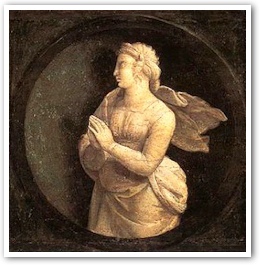The Glory of the Lord
- FR. KENNETH BAKER, S.J.
The Nicene Creed says not only that Jesus will come again at the end of world history, but it also gives a biblical description of his coming by adding that he will come in glory.
 |
The idea of "glory" and the "glory of God" occurs throughout the Bible, so we might do well to reflect on this datum of revelation for a few moments.
In the Hebrew Bible the word for "glory" (kabod) originally meant weightlessness. If something was heavy and large it was important, like a mountain, and so it inspired respect. The basis of glory could be riches. Abraham was said to be "very glorious" because he possessed cattle, silver and gold (Gen 13:2).
The Expression "the glory of the Lord" means God himself insofar as he is revealed in his majesty, his power and his holiness. He manifests himself in two ways: in his lofty deeds and by his appearances to Abraham, Moses and the prophets. God showed his glory especially in the miracle of the Red Sea (Ex 14:18) and also the manna and the quail (Ex 16:7). The divine appearances are normally accompanied with disturbances of nature, such as thunder, lightning, fire, earthquakes, clouds. These phenomena manifest the glory of God; the cloud that surrounds the glory is there for the protection of man, for no man can see God and still live (Ex 33:20).
The glory of God, in the form of a cloud, filled the Tent of Meeting where Moses spoke with the Lord (Ex 33:9). It also filled "the house of the Lord" that Solomon built (1 Kings 8:10-11). As time went on the idea of God's glory developed in the prophets from clouds and fire to the notion of illumination. We find this in Ezekiel 1 and Isaiah 60.
After the Exile (537 B.C.), the Jews came more and more to realize that the power of the Lord extended over the whole world. Thus his glory is shown in his dominion over all nations and all creatures. The Psalms often called upon all creatures to praise the glory of the Lord (cf. PS 57; 97; 145-50). But the one passage in the Old Testament to which the "coming in glory" of the Creed refers, more than to all others, is the description of the "son of man" in the prophet Daniel (7:13-14): "I saw one like a son of man coming on the clouds of heaven He received dominion, glory and kingship; nations and peoples of every language serve him." This passage is commonly interpreted as referring to Jesus Christ who will "come in glory to judge the living and the dead".
Glory in the sense of majesty, power, dominion, illumination, holiness belongs primarily to God. Men like Moses or the saints can share in the glory of God by doing his will and by growing in virtue.
Isaiah says that "all the earth is filled with his glory" (Is 6:3). The glory of God in this sense can mean: 1) the divine protection, and 2) the praise that creatures give to God because of his glory. The sense of this text from Isaiah is that all creatures reflect the wisdom and perfection of God. And by their very existence, as a reflection of God's perfection, they give praise to their Creator. Man alone among all creatures on earth gives praise to the glory of God not only by his physical existence, but also by consciously acknowledging the goodness and the love of God.
The motto of St. Ignatius Loyola, founder of the Jesuit Order, was Ad Maiorem Dei Gloriam "For the Greater Glory of God". The phrase came so spontaneously to his lips that it appears on almost every page he ever wrote. Ignatius was so captivated by the love and goodness of God that he would spare no effort to give recognition to God and to praise him by a life of virtue and sacrifice.
Christian painters surround their images of Christ and the saints with reds and yellows and white to indicate their glory. This is an attempt, through the impression of illumination, to indicate their glory. By faith, we know that Jesus Christ will come again in glory the blazing light, clouds and fire are symbolic of his definitive triumph over evil and death and his everlasting dominion.
See the index of chapters from Fundamentals of Catholicism which have been reprinted to CERC here.
 This is Meaghen Gonzalez, Editor of CERC. I hope you appreciated this piece. We curate these articles especially for believers like you.
This is Meaghen Gonzalez, Editor of CERC. I hope you appreciated this piece. We curate these articles especially for believers like you.
Please show your appreciation by making a $3 donation. CERC is entirely reader supported.

Acknowledgement
Kenneth Baker, S.J. "The Glory of the Lord." In Fundamentals of Catholicism Vol. 1 Chapter 27 (San Francisco: Ignatius Press, 1995), 82-84.
This article reprinted with permission from Father Kenneth Baker, S.J.
The Author

 Father Kenneth Baker, S.J., assumed editorship of Homiletic & Pastoral Review in April 1971 and remained in this position for almost forty years. In 1983 he published a three-volume explanation of the faith called Fundamentals of Catholicism Vol. 1, Creed and Commandments; Vol. 2, God, Trinity, Creation, Christ, Mary; and Vol. 3, Grace, the Church, the Sacraments, Eschatology
Father Kenneth Baker, S.J., assumed editorship of Homiletic & Pastoral Review in April 1971 and remained in this position for almost forty years. In 1983 he published a three-volume explanation of the faith called Fundamentals of Catholicism Vol. 1, Creed and Commandments; Vol. 2, God, Trinity, Creation, Christ, Mary; and Vol. 3, Grace, the Church, the Sacraments, Eschatology




